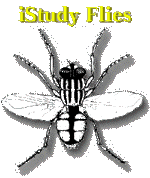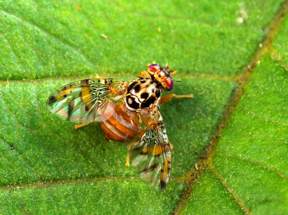
|
iStudy Flies - Scourge of the Medfly
SCOURGE OF THE MEDFLY
Attacking more than 200 varieties of fruits and vegetables, the female Medfly pierces the soft skin of the ripening fruit and lays its eggs. The resulting larvae (maggots) feeds upon the fruit, making it unfit for human consumption. [42] Though the Medfly maggot (larva) is capable of amazing leaps of 4 inches (100 mm) high and 8 inches (200 mm) in distance, the adult Medfly is not a strong flier. [43] Since the most common means of spreading the Medfly is through larvae infested fruit, quarantine against the importation of products from infested areas is the primary means of controlling the Medfly. [44] Because of the fear of loss of hundreds of millions of dollars of crops to a local economy alone, such as the tomato and citrus crops of Florida, the organophosphate pesticide malathaion has been approved for aerial spraying by the U.S. Environmental Protection Agency (EPA) to control the Medfly outbreak, e.g., June 4, 1998. [45] Scientists of the U.S. Department of Agriculture have developed laboratory-bred, sterile male Medflies to be released to breed with wild female Medflies. The resulting generation of infertile offspring "crashes" the Medfly population. In the laboratory, Medfly eggs are bathed in 97°F (36.1°C) for 12 to 24 hours -- killing only eggs with female embryos. The male eggs are then irradiated, rendering them sexually sterile. [46] On May 10, 2005, the United Nations News Service reported that a natural control of the Medfly is being accomplished by the Palestinian Authority and Israel in the Mediterranean Basin through a collaboration of Israel, Jordan, the Palestinian Authority, and two United Nations agencies, where the sterile insect technique (SIT) has treated 15 million male Medflies in Guatemala before their release each week in the Occupied Palestinian Territory and Israel. The result has been an increase from $1 million to $50 million in bell pepper exports from Israel's Arava Valley (1998-2005). [47]
|
Member of Fohn.net
